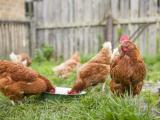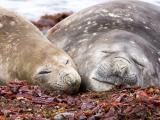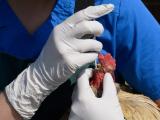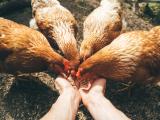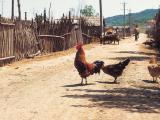Jan 6, 2006 (CIDRAP News) – 2005 is likely to go down as the year when avian influenza, powered by a steady rise in human cases and the spread of poultry outbreaks all the way to Eastern Europe, emerged as a high-profile global health issue.
When 2005 dawned, only 45 human cases of H5N1 avian flu, including 32 deaths, had been counted by the World Health Organization (WHO). All of those were in Vietnam and Thailand.
A year later, the count had jumped to 142 cases with 74 deaths, including a number of cases in three previously unaffected countries: Cambodia, Indonesia, and China. (Turkey joined the list this week.)
As human cases increased, outbreaks in poultry marched westward, reaching parts of Central Asia in the summer and as far west as Romania in the fall. The virus's westward spread drew unprecedented attention around the world, fueling a flurry of planning efforts and a rush for the antiviral drug oseltamivir (Tamiflu), thought to have some protective potential against H5N1.
On the research front, a clinical trial of an H5N1 vaccine being developed in the United States showed that it produced an adequate immune response, but it required a very large dose, which dimmed hopes for adequate vaccine supplies.
What didn't happen in 2005, of course, was a human pandemic. By the end of the year, the virus still had not shown an ability to spread easily from person to person. Yet scientists reported evidence of at least 15 family clusters of cases in Vietnam, suggesting that person-to-person spread may be less rare than it appears.
The absence of a pandemic was the only positive news about avian flu in 2005, in the view of Michael T. Osterholm, PhD, MPH, director of the University of Minnesota Center for Infectious Disease Research and Policy, which publishes this Web site.
"The only good news is that we've not yet seen it become a pandemic strain," he said.
The winter of 2004-05 made it clear that H5N1 flu would continue to increase and spread among domestic birds, Osterholm said. That means the virus has continuing opportunities to mutate into a humanly contagious pathogen.
"The trillion-dollar question is, if this virus has virtually unlimited opportunities to accumulate mutations through its ongoing domestic bird transmission, does it have the potential to result in a competent human pathogen?" he said.
If it doesn't, the persistent outbreaks in birds have limited human consequences, Osterholm said. But he views that as highly unlikely.
"I don't know of anything in influenza research that suggests that this virus could not one day accomplish an accumulation of mutations that would allow it to become a human-to-human agent," he said.
"Some have concluded that because reassortment [combination of the H5N1 virus with a human flu virus] hasn't occurred, it can't accomplish human transmission. Well, the 1918 virus didn't reassort either," he said. He referred to recent research showing that the 1918 virus was an avian virus that adapted to humans without trading genes with a human flu virus.
Human cases and poultry outbreaks
A human case of avian flu reported in Cambodia last February marked the first one outside Vietnam and Thailand. Three more Cambodian cases followed within a few months, and the first symptomatic cases in Indonesia emerged in July. By the end of the year Indonesia had had 16 cases, 11 of them fatal.
China reported its first two human cases since 2003 in mid-November, and five more have been reported since then. (Two human H5N1 cases in Hong Kong in February 2003—before the current poultry epizootic began—were believed to have originated in China.)
Human cases continued to accumulate in Vietnam in the course of the year, rising from 28 cases with 20 deaths at the end of 2004 to 93 cases with 42 deaths a year later. Thailand escaped without any new cases until October but then had several.
On the poultry front, milestones included the discovery of wild birds dying of H5N1 at Qinghai Lake wildlife refuge in north-central China in May, triggering fears that birds using the refuge would spread the virus far and wide. Those fears came true to some extent in ensuing months. In late July the virus turned up in poultry in the Novosibirsk region of Russia, and in August it was found in Kazakhstan and Mongolia.
In October the virus was discovered in northwestern Turkey and in nearby eastern Romania. More recently outbreaks have been reported in eastern Turkey and southern Ukraine as well. The virus's westward movement prompted the WHO to warn in late October that migratory birds could carry it to Africa, though that outcome hasn't been reported so far.
Research milestones
In August the National Institutes of Health (NIH) reported that an experimental H5N1 vaccine generated an immune response in volunteers, raising hope that it could help protect people if the virus evolved into a pandemic strain. But the bad news was that the amount of antigen it took to generate a good response was a dozen times the amount in a seasonal flu vaccine. That suggested it would be virtually impossible to produce enough of the vaccine to protect most Americans, let alone the worldwide population.
There was hope that the use of an adjuvant—an immune-boosting additive—could greatly reduce the necessary amount of antigen in the vaccine. But in December, Sanofi Pasteur reported that even with an adjuvant, the vaccine dose needed to generate a good immune response was still four times as much as in a seasonal flu vaccine.
Osterholm commented, "Any hopes we had of taking the current vaccine supply and expanding it were seriously dashed with the NIH and Sanofi studies. Until we have a fundamental production revolution, both in terms of new vaccines and in vaccine manufacturing capacity, we'll still have at best a very limited ability to deal with pandemics by means of vaccines."
In other research, a report published in October revealed unsettling parallels between the 1918 pandemic virus and today's H5N1 virus. Scientists reported that the 1918 virus was an avian strain that succeeded in adapting to humans without first acquiring genes from a human flu virus. The researchers also reported that several of the mutations that differentiated the 1918 virus from purely avian viruses are also found in the H5N1 virus.
Political developments
Policy makers in much of the world, and especially in the United States and Europe, started showing a new level of urgency during the fall. President George W. Bush, addressing the United Nations in mid-September, called for an international partnership to combat the threat.
As November began, Bush called on Congress to provide $7.1 billion for pandemic preparedness, most of it for vaccines and antiviral drugs. Congress responded in December by passing a $3.8 billion measure, which included a liability shield for pharmaceutical companies.
The day after Bush's call for funding, his administration released its lengthy and long-awaited pandemic plan. The plan assumed the possibility of a pandemic sickening up to 30% of the population, a much larger epidemic than suggested in preliminary versions of the plan. The document was marked by a strong emphasis on vaccines and drugs. It was criticized as offering too little guidance and support for state and local health agencies.
Federal officials followed up on the plan's release by announcing a series of state summit meetings on pandemic preparedness, the first of which was held in Minnesota in December.
Editor's Note: Individual CIDRAP News stories on the events and research mentioned above, with links to original sources where available, can be accessed through the Avian Flu and Pandemic Flu news archives.
